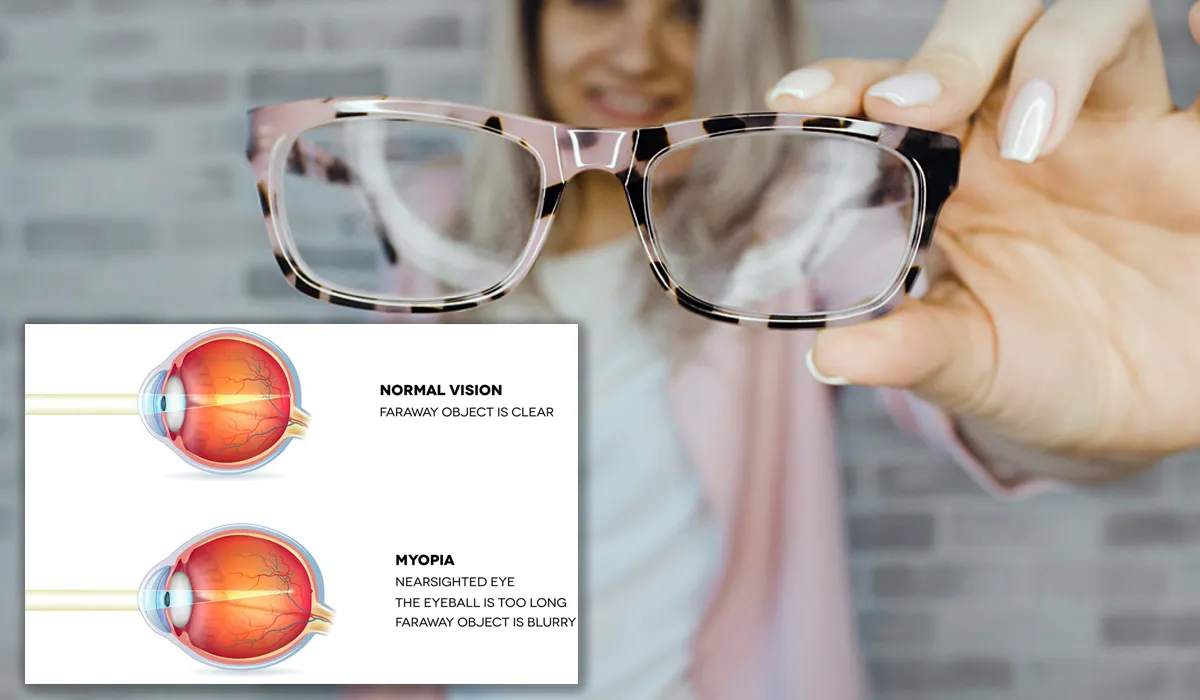Genetics and Myopia
Understanding Genetics in Myopia
Development
FSDAVCFEBFEVSDDVFSD
FSDAVCFEBFEVSDDVFSD
FSDAVCFEBFEVSDDVFSD
Genetic Insights into Myopia Development
Why do some people develop myopia, or nearsightedness, while others maintain perfect vision throughout their lives? Myopia, which causes distant objects to appear blurry, is a condition that affects millions globally. Is it influenced by our environment, or is it written in our genetic code?
The role of genetics in myopia is a fascinating area of study that holds many clues. This article will discuss the genetic factors behind myopia, the impact of family history, the interaction between genetic predisposition and environmental influences, and the latest advancements in genetic research related to this condition. As we cover these aspects, the complex picture of myopia's origins and development will start to unfold.
Why do some people develop myopia, or nearsightedness, while others maintain perfect vision throughout their lives? Myopia, which causes distant objects to appear blurry, is a condition that affects millions globally. Is it influenced by our environment, or is it written in our genetic code?

The role of genetics in myopia is a fascinating area of study that holds many clues. This article will discuss the genetic factors behind myopia, the impact of family history, the interaction between genetic predisposition and environmental influences, and the latest advancements in genetic research related to this condition. As we cover these aspects, the complex picture of myopia's origins and development will start to unfold.

The Genetic and Environmental Factors Influencing Nearsightedness

Myopia, or nearsightedness, causes distant objects to appear blurry while close objects remain clear. This vision problem affects millions of people globally. The development of myopia is significantly influenced by genetic factors, with specific genes inherited from parents playing a major role. Family history is a key risk factor, as children with myopic parents are more likely to develop the condition due to hereditary myopia.
Studies have shown that genetic predisposition can significantly influence myopia development. For instance, certain genes related to eye growth and development are often found in individuals with myopia, highlighting the importance of genetics in this condition.

However, genetics is not the sole contributor to myopia. Environmental factors like prolonged screen time, limited outdoor activities, and poor lighting also play a significant role. These factors can exacerbate the condition, especially in individuals already predisposed to genetic eye conditions. Understanding these myopia causes and risk factors is important in addressing and managing the condition effectively. Ongoing myopia research continues to examine the intricate relationship between genetic predisposition and lifestyle influences, offering hope for better prevention and treatment strategies
Genetic Factors in Myopia
Genetic factors play a pivotal role in the development of myopia. Research has identified several genes associated with myopia development, with some genes directly influencing the structure and function of the eye. For instance, the PAX6 gene is crucial for eye growth and development, and variations in this gene are often linked to higher myopia risk.
A family history of myopia significantly impacts the likelihood of developing the condition. If one or both parents are myopic, the chances of their children inheriting myopia increase substantially. This genetic predisposition suggests that hereditary factors are strong determinants of myopia.
Apart from PAX6, other genes like ZFHX1B and LAMA2 have been studied for their roles in genetic eye conditions. These genes influence the eye's refractive development, contributing to the lengthening of the eyeball, which causes nearsightedness. The study of these genes and their variations helps in understanding how myopia inheritance works. It also opens pathways for potential genetic interventions. Scientists are continuously investigating these genetic markers to develop targeted treatments that can mitigate the effects of genetic myopia.
This ongoing myopia research not only enhances our understanding of the genetic basis of myopia but also offers promising avenues for future therapies. As we continue to decode the genetic underpinnings of myopia, we move closer to more effective and personalized approaches to manage and prevent this widespread condition.
The Role of Family History in Myopia Development
Family history plays a significant role in the likelihood of developing myopia. Studies have consistently shown that children with one or both parents affected by myopia are at a higher risk of inheriting the condition. This strong genetic link highlights the importance of understanding how hereditary myopia impacts individuals, influencing not only the risk of onset but also the potential severity and progression of the condition across generations.
If both parents have myopia, their children have a significantly higher chance of developing the condition compared to children with non-myopic parents. This pattern of myopia inheritance underscores the genetic predisposition to this vision problem. The specific genes passed down through generations influence the eye's development and can lead to nearsightedness.


Research indicates that the more severe the parents' myopia, the greater the risk for their children. This suggests that not only the presence but also the degree of myopia in parents can be a predictor for the condition in their offspring. Identifying these myopia risk factors is crucial for early detection and potential intervention.
Understanding the family history of myopia can help in anticipating the development of the condition and implementing preventative measures. Regular eye check-ups and monitoring can aid in managing and potentially slowing the progression of myopia in children predisposed to it genetically.
3: Ortho-K Provides Quick Results
One of the most appreciated features of Ortho-K is its rapid effectiveness. Many patients report significant improvements in their vision within just a few days to weeks of starting treatment. This quick turnaround is particularly advantageous for those who need immediate results from vision correction. Ortho-K works overnight to reshape the cornea, and upon waking, users often notice clearer vision.
This immediate impact makes Ortho-K an appealing option for those seeking a fast alternative to more traditional, slower-acting vision correction methods. The ability to achieve noticeable vision improvement quickly is highly valued, making Ortho-K a popular choice for individuals looking for an effective and timely solution to their vision problems.
Advances in Genetic Research and Myopia Treatment
Recent advancements in genetic research have significantly enhanced our understanding of myopia and opened new avenues for treatment. Researchers have identified numerous genes associated with myopia development, providing deeper insights into the genetic mechanisms that drive this condition.
One promising area of research involves gene therapy, which aims to correct or modify the genes responsible for hereditary myopia. By targeting specific genetic mutations, scientists hope to develop treatments that can prevent or reduce the severity of myopia. Innovative approaches like pharmacological interventions are also being explored. These treatments aim to regulate the growth of the eyeball by influencing the genetic pathways involved in its development. As genetic research progresses, the potential for more effective and targeted myopia treatments grows, offering hope for better management of this widespread condition.
Recent advancements in genetic research have significantly enhanced our understanding of myopia and opened new avenues for treatment. Researchers have identified numerous genes associated with myopia development, providing deeper insights into the genetic mechanisms that drive this condition.
One promising area of research involves gene therapy, which aims to correct or modify the genes responsible for hereditary myopia. By targeting specific genetic mutations, scientists hope to develop treatments that can prevent or reduce the severity of myopia. Innovative approaches like pharmacological interventions are also being explored. These treatments aim to regulate the growth of the eyeball by influencing the genetic pathways involved in its development. As genetic research progresses, the potential for more effective and targeted myopia treatments grows, offering hope for better management of this widespread condition.
Final Thoughts on the Genetics of Myopia
Grasping the genetic underpinnings of myopia is crucial for understanding its development and management. Genetics significantly influence myopia, but environmental factors also play a critical role in its progression. Recognizing the interaction between these elements aids in forming effective prevention and treatment strategies.
So, If you or your family members are affected by myopia, stay informed about the latest research and preventive measures. For personalized care and a comprehensive range of vision services, visit Kleinwood Vision. Schedule an appointment today and take the first step towards a better vision.

Contact Info
Hours of Operation
Mon - Fri | 9:00 AM - 5:00 PM
Sat - Sun | Closed
Holiday Hours: We are closed for the following holidays: New Years Day, Memorial Day, Independence Day, Labor Day, Thanksgiving Day, Christmas Day
© 2025 Kleinwood Vision. All rights Reserved.


